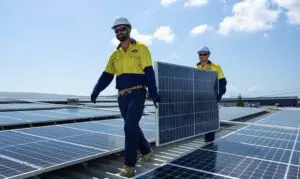ASX-listed Carnegie Wave Energy has successfully completed 12 months of operations of its ground-breaking CETO 5 Perth Project, thus ticking off the final milestone required for its various government grant funding agreements with both state and federal governments.
Carnegie officially switched on the onshore power station for its Perth Wave Energy Project a year ago, marking the launch of the world’s first commercial-scale grid connected wave energy array and the first time in Australia that wave-generated electricity has been fed into the grid.
The WA-based company said in a statement on Wednesday it had now submitted all grant milestone invoices to the WA government’s Low Emissions Energy Development (LEED) Fund and the Australian government’s Australian Renewable Energy Agency (ARENA).
Additionally, the company said on Wednesday it had also recently received a $200,000 CETO 6 milestone payment from ARENA for completion of the concept design.
As reported here in October last year, the CETO 6 design has a number of advantages over the CETO 5 model, including a roughly four-times increase in rated capacity to 1MW.

The new design also eliminates the need for heavy offshore lifts (and associated costly heavy lift vessels), adding to a much simplified installation and maintenance program.
Further the CETO 6 has more advanced control systems, with power generation contained inside inside the Buoyant Actuator, which goes to increased system efficiency.
An electrical export cable (or umbilical) is also used to deliver the power onshore, reducing transmission losses compared to the current CETO 5 Perth Wave Energy Project, which uses a pipeline with high pressure fluid.

 Carnegie says the incorporation of the power generation equipment offshore also increases the market for CETO, making it able to take advantage of deeper, and further off-shore wave resources and sites.
Carnegie says the incorporation of the power generation equipment offshore also increases the market for CETO, making it able to take advantage of deeper, and further off-shore wave resources and sites.
The team has also identified a preferred project site for the CETO 6 array, some 10km offshore from Garden Island.
In December, Carnegie Wave announced it had been awarded $800,000 of funding from the Australian government towards its plans to use its CETO technology to develop a renewable energy microgrid for the island nation of Mauritius.
The Mauritius project would be based on the company’s Garden Island Microgrid Project, which – announced last year – will consist of Carnegie’s CETO 6 array, the existing reverse osmosis desalination plant currently operating on Garden Island after being switched on in October, plus 2MW of solar PV power generation and sufficient energy storage to allow safe, stable and reliable interaction with the electricity grid.

One of the main aims of the Garden Island project has been to provide a viable commercial model for islands, and edge of grid and remote communities.
And it has already generated a lot of interest. In April, Carnegie signed a deal to develop wave energy projects in Chile and Peru, to help supply renewable energy and water to some of the region’s remote island outposts.
The funding for the Mauritius project, which will be controlled by the Mauritian Ministry of Finance and Economic Development, will go towards the study and design of high penetration renewable energy microgrids incorporating wave energy on Mauritius and the neighbouring island of Rodrigues.
Just two weeks earlier, Carnegie closed its latest funding round, having raised $7.5 million towards the commercialisation of its CETO technology – $2.5 million more than it had hoped to raise.
Carnegie said on Wednesday it had now received 100 per cent of the grant payments from the WA government, and was set to receive another $955,043 from ARENA, having has submitted the final CETO 5 milestone invoices.







